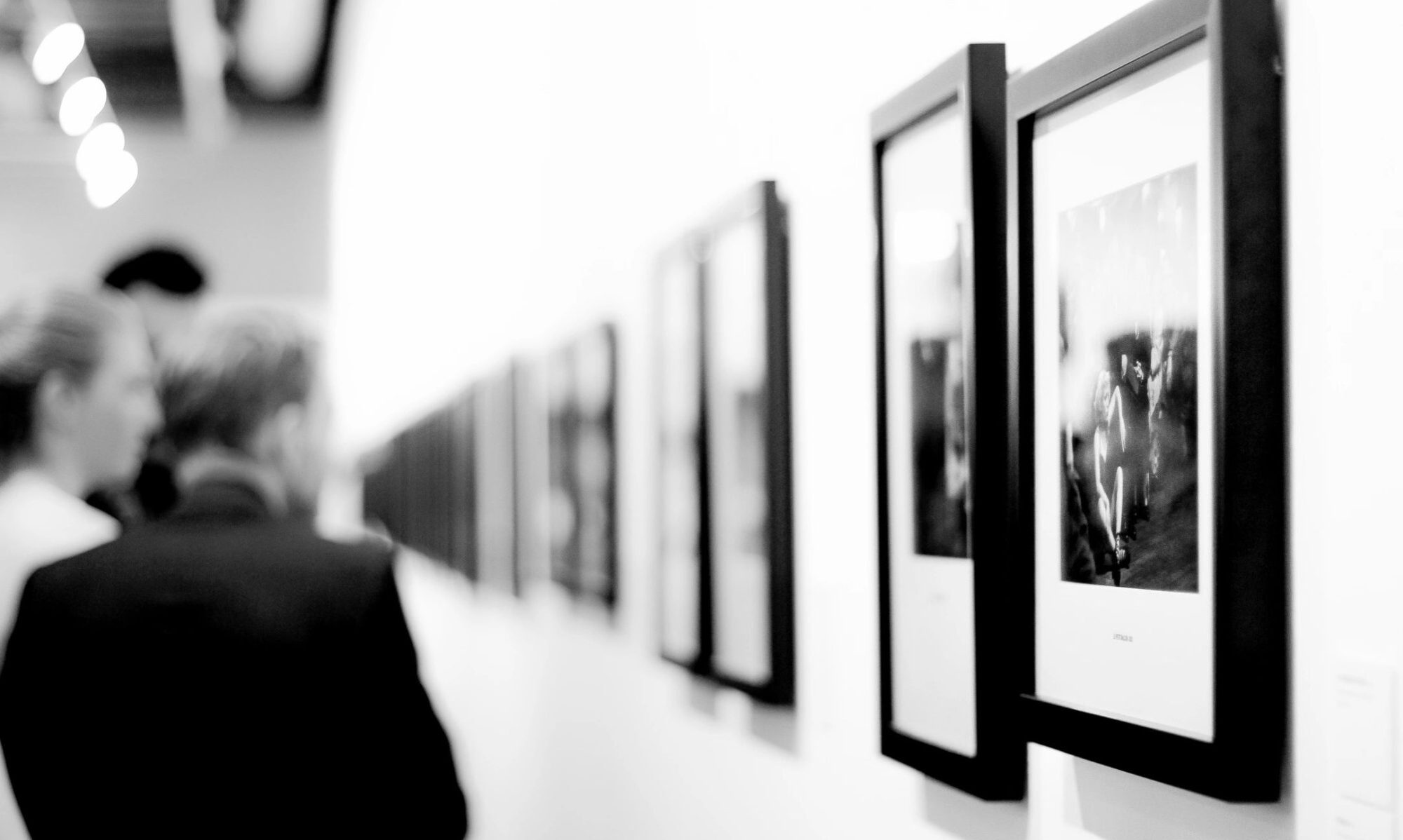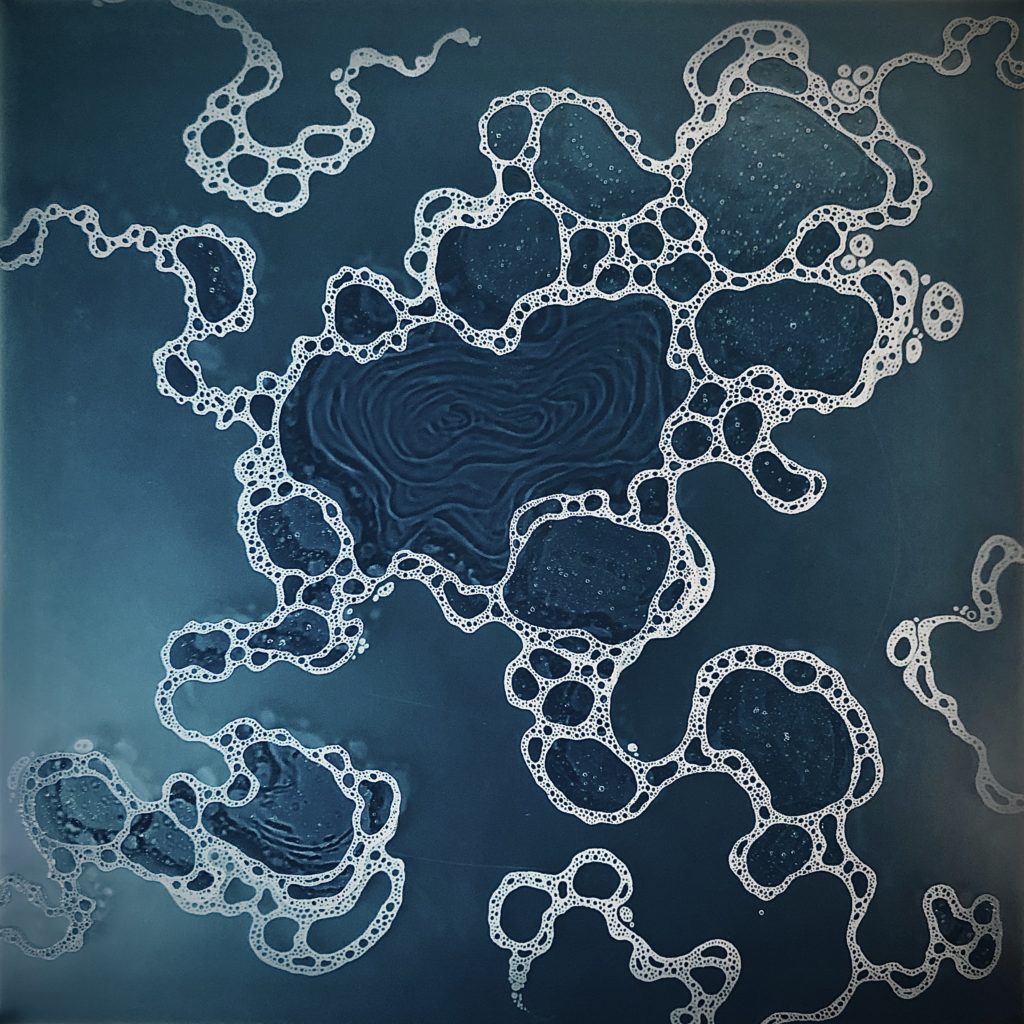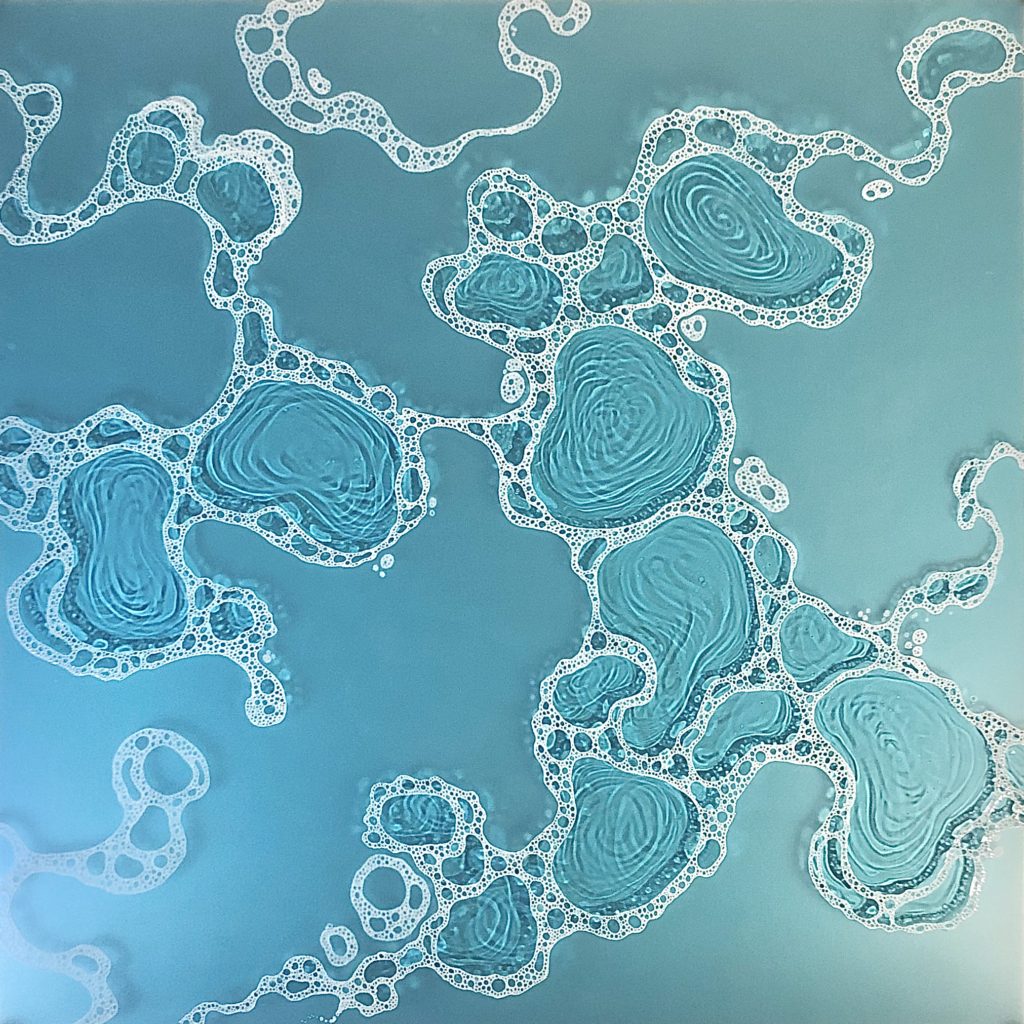31 Women – March 2nd: Carla Goldberg
Stratford Panel 1 and 2, 2020
Oil ink, enamel, resin on acrylic panels
An Interview with Carla Goldberg
MKM: Tell me about your childhood, where did you grow up? Were you always creative?
CG: I grew up in a retirement condo with my grandparents in Palm Springs California. I have been making art since I was four, and in fact have known I was going to be an artist since then. I blame it on a Bugs Bunny episode where Bugs is running away from that big red furry monster and at one point blends into the background dressed as a french artist. I remember asking my grandma what he was doing and she explained and I said I want to do that. Then I begged her for paints and canvas, a french beret and smock and art classes non-stop. I was either very persuasive or just broke her down. She was amazing and supportive. She took me to the only art class she could find. An adult painting class 2 bus transfers away at the WMCA. She convinced them to let me in at only four years old. I behaved when I had a paintbrush in hand.
MKM: Why did you pursue art?
CG: I paint in my sleep, so it isn’t something I can ignore. I don’t just dream of making art. I wake often with my arm in the air painting the air. I once gave myself a black eye when my hand that only moments earlier was hovering in the air with me wondering why it was up there came down smack on my eye in the moment of acknowledgment that that was weird.
MKM: Where did you study?
CG: University of Redlands- Johnston Center for Integrative Studies, with Honors. An incredible program where you don’t get traditional grades but rather evaluations and you evaluate the professors. You can create your own classes as well. I had gone through every art class they had by the end of my junior year so my senior year all the art classes we projects I worked with one on one with my professors. It was the beginning of a lifetime of chasing ideas and experimenting. I still had a great foundation in classical art studies but was able to accelerate learning down this path of experimentation that last year. For my MFA I found another program similar to Johnston at MICA Mount Royal School of Art where experimentation was emphasized.
MKM: Memorable teachers?
CG: I’ve been really lucky to have a slew of teachers that took me seriously and really supported me or changed the way I think. The two professors that probably had the most profound effect on me were Sal Scarpita and Babe Shapiro, my professors at MICA. They would have these fights over my work. One would love it and the other hated it. Seriously loud debates. So I’d listen and change things and they would switch places. The one who loved my work would then hate it. After a year of this I was so frustrated I broke down in front of them. I lost it for the first time ever balling my eyes out crying I can’t please you both! I don’t know what I’m doing! But suddenly had the revelation that they were playing with me trying to get me to learn to listen to my own voice and stop painting to please others. That it doesn’t matter who likes or doesn’t like my work. It was a profound moment that allowed me to finally own my own work and creative voice. I am forever in their debt for that. Turns out they actually both liked my work. Those little devils!
MKM: When you’re creating what’s your daily routine? Rituals, patterns?
CG: Coffee!!!! A must and plenty of it. When I am finally ready to work, it’s usually around 2pm. I am a late night kind of person. I’ll take a break to cook a nice dinner but I start work again around 10 pm and work till around 3 am. It’s quiet then. No phones ringing, no one asking me for anything. Total undisturbed time to think full thoughts to their logical end, plenty of time to make art. I get at least 8 hours of work in most days. I also take some days, or between waiting for work to dry, to work on PR or searching venues, galleries, exhibitions opportunities. I am rarely doing nothing.
MKM: How has your practice changed over time?
CG: Obviously when my kids were babies and really young, I could not stay up late so I would drop them off to school and work till pick up. It never felt right. It was always this fight with my internal circadian clock. But some things never changed. I was always chasing ideas and experimenting with materials. My children would experiment with me too. I’d often have art materials out ready for them to use along with me.
MKM: Do you focus on a specific medium or combination of mediums? Which creative medium would you love to pursue but haven’t yet?
CG: I work with a lot of unlikely materials. Many have industrial applications. Most of my work is put together with resin and plexiglas usually figures in the work because of its ability to give support to the work but also kind of disappear if I want it to. I am very interested in encaustic but haven’t had a chance to try it yet. I’m also really interested in gelatin prints. You literally print on a sheet of jello. I did a lot of printmaking in college and gelatin prints allows you to print without a press, leaving you really portable and they are one of a kind works on paper.
MKM: What themes do you pursue?
CG: Some of my work is political when it deals with the environment and I pull in remnants from the homebuilding industry. I try to rescue as much plexi as possible from going into the dump and often pick up remnants that my supplier has saved for me. Themes weigh more heavily in the memory of water and the preciousness of water. We are all conned by water across this whole planet. We are mostly water ourselves. Since I experiment so much and have a new series every year, I need something that ties all the work together. Keeping the subject about the memory of water allows for a lot of varied materials, yet does pull it together via theme. I recently had my 10th anniversary at BAU Gallery where I do my experimenting each year, and presented a retrospective of those experiments.
MKM: What is your most important tool? Is there something you can’t live without in your studio?
CG: Probably my level. If I want a good resin pour, my plexi had better be level. Resin is like juggling honey. It’s going to go to the lowest spot, so that level is key to having it stay where I pour it. Also important is my blowtorch. Without that, I will have cloudy resin. The blowtorch removes bubbles.
MKM: What inspires you? Other artists, other women from history, your process, a theme?
CG: I tend to be more influenced by the artists around me currently making art. It’s a rift on ideas in conversations or sharing information, discoveries, just bouncing ideas off of each other. Some of my favorite time, especially when stuck trying to figure out my next series, is getting together with fellow artists (mostly women) for breakfast, just spending the whole morning and afternoon talking. I am refreshed and energized after a day like that. It’s important to have community and a sense of camaraderie. Making art can be a lonely experience. I don’t let that happen.
MKM: Do you have a sense of connection to a particular woman artist from art history? Is there a specific work from this artist that you find interesting?
CG: Yayoi Kusama and her infinity work with all those polka dots is very inspiring. The Queen of Polka Dots! My own seafoam drawings are comprised of hundreds of thousands of micro polka dots, so I gotta love Kusama. She was so experimental and such a fighter in her early career. Always having to fight against sexism in Japan and in the heart of the NY Art scene. Men stealing her ideas and taking the credit. Her eventual rise to absolute dominance is something truly astounding to me. How did it happen? I think her talent was just too big to be ignored forever. Her dedication to her daily routine despite her challenges is something I deeply feel akin to. I also struggle with health issues and honestly, art keeps me going. I admire Helen Frankenthaler’s stain paintings. Again it’s someone who experiments and thinks out of the box that paint can be stain and canvas can be raw. That’s exciting to me. I also use a lot of stains and pooling of paint. I also feel a connection to Agnes Martin’s minimalist paintings which to me are these tiny lines of humanity. They force you to concentrate on the tiniest lines of the imperfect human hand in a field of order. Pattern, texture and light is what I see in her work. Although my lines are looser, my work is about line, pattern, light and shadow.
MKM: Who are your female role models from history or present day?
CG: Lisa Zukowski is a friend of mine and she is a master of every medium she touches. She is an artist who has taught me so much, helped me to get a backbone in business, taught me how to hang shows and run a gallery, as well as how to put a show together. She doesn’t even realize how much of a mentor she is to me. I admire her art. Her talent. Her no nonsense approach. She is one of the artists who I love to get together with and bounce ideas around with her.
MKM: What’s the best piece of advice you’ve been given?
CG: Don’t give others power over your emotions or your self worth. This is a business. If they say no, don’t give up. NEXT! Move on and find a yes. Keep building. Make your own projects. Think out of the box. Reapply with better work.




